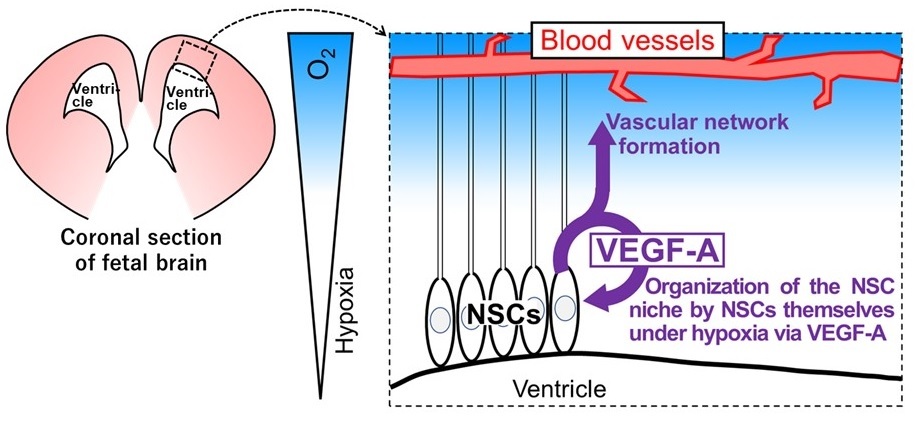Filling a Niche: Neural Stem Cells Help Maintain Their Microenvironment
Researchers from Tokyo Medical and Dental University (TMDU) shed new light on the characteristics of the niche in which neural stem cells reside in the developing brain
Tokyo, Japan – When it comes to cell types, stem cells have unlimited potential – literally. These self-renewing cells, which are capable of giving rise to any cell type in the body, reside in specialized microenvironments known as niches. Now, researchers in Japan have shed new insight into the dynamics of the neural stem cell niche, the home of stem cells in the brain.
In a new study published in Inflammation and Regeneration, researchers from Tokyo Medical and Dental University (TMDU) investigated the effects of hypoxic (low oxygen) conditions on the neural stem cell niche during development.
Neural stem and progenitor cells (NPSCs) give rise to the cells of the brain and nervous system. NSPCs are known to reside in a hypoxic niche, meaning that oxygen levels in the niche are lower than those of the surrounding tissues. However, the composition of this niche, and how NSPCs maintain themselves within it, is not entirely clear. The TMDU-led research team set out to investigate the effects of low oxygen conditions within the neural stem cell niche using a cell culture model of NSPCs isolated from the forebrains of embryonic mice. They cultured these cells into neurospheres, or free-floating stem cell clusters, under low-oxygen and normal-oxygen conditions.
“The results were striking, with significantly increased neurosphere formation observed under hypoxic conditions compared with normoxic conditions,” says co-lead author of the study Taichi Kashiwagi. “This led us to explore what factors play a role in the maintenance and proliferation of NSPCs under hypoxic conditions.”
The researchers evaluated a protein called vascular endothelial growth factor-A (VEGF-A) as a potential candidate. When the research team added VEGF-A to the NSPC cultures, neurosphere formation was significantly increased. Conversely, blocking VEGF-A with a drug inhibitor diminished the increase in neurosphere formation under low oxygen conditions. Additionally, VEGF-A expression was found to be upregulated in NSPCs under low oxygen conditions.
“We found that NSPCs treated with VEGF-A showed lower rates of cell death and increased cell proliferation,” says senior author Tetsuya Taga. “VEGF-A is a factor that appears to contribute to NSPC maintenance under low oxygen conditions.”
These findings indicate that NSPCs help to maintain their own population through the release of VEGF-A under hypoxic conditions. While other factors may also contribute to NSPC maintenance, these results shed new light on the composition of the neural stem cell niche during development, and may serve as a foundation for further studies of self-organization of the hypoxic niche.

Organization of self-advantageous niche by neural stem cells during development under hypoxia
Neural stem cells (NSCs) produce neurons and glial cells (astrocytes and oligodendrocytes), which are major cells in the brain. NSCs are maintained and expanded by self-renewal in order to avoid depletion during neurogenesis and astrogliogenesis. During midgestation, NSCs reside under hypoxia partly due to immature vasculature. The mechanisms by which NSCs efficiently self-renew under such circumstances have not fully been discovered. To tackle these problems, we first isolated NSCs from midgestation mouse brains and cultured them under the hypoxic condition. Neurosphere formation under the hypoxic condition was dramatically increased compared that under the normoxic condition. Since neurosphere formation is a good indicator of the presence of NSCs, this result suggests a mechanism to maintain NSCs under hypoxia. Our further study surprisingly showed that NSCs cultured under hypoxia secreted vascular endothelial growth factor A (VEGF-A) and its amount was sufficient to induce NSC self-renewal. The experiments such as that using a VEGF-A inhibitor suggest that VEGF-A secreted from NSCs under the hypoxia promotes NSC self-renew and contributes to maintenance and expansion of NSCs. Our results suggest that NSCs have adaptive potential to respond to hypoxia to organize self-advantageous niche involving VEGF-A when the vascular system is immature. This study will help to elucidate mechanisms underlying not only NSC maintenance but also vascular formation in the brain at the embryonic stages since VEGF-A is an important factor for vasculature development.
Summary
Journal Article
TITLE:Organization of self-advantageous niche by neural stem/progenitor cells during development via autocrine VEGF-A under hypoxia
DOI:https://doi.org/10.1186/s41232-022-00254-2
Correspondence to
-
Tetsuya Taga, Ph.D., Professor
Department of Stem Cell Regulation,
Medical Research Institute,
Tokyo Medical and Dental University (TMDU),
E-mail: taga.scr(at) tmd.ac.jp
*Please change (at) in the e-mail addresses to @ when sending correspondence.

